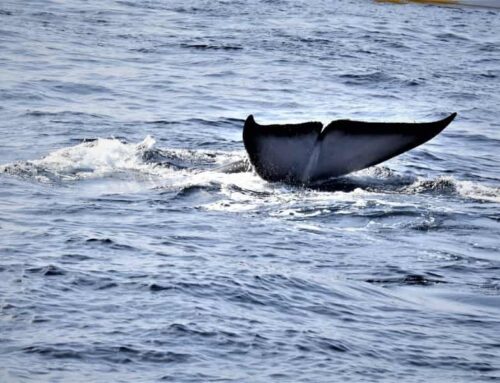The Essential Guide to an Unforgettable Whale Watching Experience
Committed to all quality standards.
Whale and dolphin watching can become one of the most impactful memories of your life. However, this experience goes beyond just getting on a boat and waiting for cetaceans to appear: to enjoy it in its full splendor, it’s good to be well-prepared and know certain guidelines for conduct and safety. Below, we offer a practical guide full of useful tips that will help you make the most of every second of this wonderful encounter with marine life.
Practical Tips for an Unforgettable Sighting Experience
When embarking on a whale watching adventure, the success of your day doesn’t only depend on the availability of the animals or the weather; the way you and your fellow travelers prepare and act during the journey also plays an important role. These tips cover everything from essential equipment to ethical behavior on the high seas.
Necessary Equipment for the Day
- Appropriate Layered Clothing
- The weather at sea can change drastically in a matter of hours. Even if you start with clear skies, wind and humidity may increase during the trip.
- It’s best to dress in layers: a breathable t-shirt, a light sweater or jacket, and, if possible, a waterproof or windproof outer layer.
- Don’t underestimate the power of the sun on the ocean: the reflection of rays on the water enhances their effect. A hat or cap and sunglasses with UV protection are essential.
- Sun Protection and Skin Care
- Apply high-factor sunscreen (SPF 30 or higher) before boarding and reapply every two hours.
- For your lips, use a balm with SPF to prevent them from drying out in the sea breeze.
- Appropriate Footwear
- Opt for shoes with non-slip soles, as the boat deck tends to get wet easily and you could injure yourself in a slip.
- Emergency Kit and Health Measures
- Carry a small first-aid kit with plasters, painkillers, and, if you’re prone to seasickness, specific medications or natural remedies like ginger candies.
- Make sure you stay hydrated. Boarding with water and some light snacks (nuts, energy bars, fruit) will keep your energy up.
- Binoculars and Camera
- A good pair of binoculars will allow you to spot cetaceans even from afar. Make sure they are waterproof if possible.
- If you plan to take photos, don’t forget spare batteries, additional memory cards, and a strap or waterproof bag to protect your camera.
Extra Recommendations for Children
- Make sure to tell them where they are going; it’s important for them to know they are getting on a boat to spot marine wildlife. Sometimes, younger children can get scared if they are not used to being on a boat.
- If you’re traveling with little ones, bring entertainment on board: drawing pads, storybooks, or toys that won’t easily fall overboard.
- Check if the tour operator provides life jackets adapted to their height and weight.
Tips for Whale Photography
Successfully capturing the majesty of whales not only requires skill but also an understanding of certain technical and behavioral details:
- Ideal Photography Equipment
- A camera with optical zoom (or a telephoto lens) is almost essential, as you won’t always get close enough to the animals.
- For video, try to use stabilization (gimbal, marine tripod, or integrated stabilization function) as wave motion can cause vibrations.
- If you have a waterproof camera or housing, you won’t have to worry about splashes.
- Recommended Settings
- High shutter speed (1/1000 or more) to freeze the movement of jumps and fins.
- Burst mode to take several photos in seconds, ensuring you capture the dorsal fin or the moment the head emerges.
- Avoid using flash: besides being ineffective during the day, it can scare the animals.
- Composition and Angles
- Try to anticipate the whale’s trajectory and focus on the point where you think it will surface.
- Take advantage of scene elements: if a cliff appears in the background, if there are reflections on the water, or if the sunset light creates reddish tones. These details can add an artistic touch to your shots.
- Patience and discretion are key: don’t move abruptly around the deck or block others’ views.
- Respect for Wildlife
- Don’t insist on getting too close to get the “perfect” photo. Maintaining the regulatory distance is essential to avoid altering the cetaceans’ behavior.
- Invasive behavior can force animals to dive or move away, harming the entire group and future visitors.
How to Act During a Close Encounter
Sometimes, luck is on your side, and you have the opportunity to observe whales or dolphins extremely close to the vessel. In these situations, it’s vital to remain calm and adhere to certain rules:
- Maintain Calm and Prudence
- Avoid shouting or clapping: excessive noise can disturb the animals.
- Do not dangerously approach the edge of the boat, especially if there are waves. Use the railings to secure your balance.
- Respect the Minimum Distance
- Cetacean protection laws require distances ranging from 50 to 60 meters, depending on the species and region.
- If the whale or dolphin approaches voluntarily, enjoy the moment, but do not try to touch them or throw anything into the water.
- Follow the Guide’s Instructions
- The captain or onboard guide is trained to assess the situation and react if the animal changes its behavior.
- If they tell you to move to another part of the deck or to be quiet, do so without hesitation: this ensures your safety and that of the cetacean.
- Observe Without Interfering
- The goal is to observe the whale’s natural behavior: how it breathes, how it dives, how it surfaces.
- Hindering their movements or trying to force an interaction can lead to stress for the animal, ruining the experience for everyone.
Anecdotes of Memorable Encounters
- There are reports of bottlenose dolphins approaching to “greet” or swimming alongside the boat’s bow.
- Occasionally, pilot whales show curiosity, especially younger individuals, and may swim near the vessel for several minutes.
Etiquette and Rules of Conduct at Sea
The conservation of the marine environment and good coexistence on the boat largely depend on each passenger’s behavior:
- Onboard Coexistence
- Share the space respectfully: yield your spot at the railing so others can also observe.
- Avoid actions that generate dirt, such as throwing food scraps or trash into the water. Always carry a bag for waste.
- Minimize Noise and Disturbances
- Engines and conversations already generate a level of noise that can affect cetaceans, so try not to unnecessarily add to the commotion.
- Listen to the captain’s instructions: they will often know when to reduce speed or turn off engines so as not to disturb the animals.
- Environmental Responsibility
- Use sunscreens and products that do not contain chemicals harmful to marine life.
- If possible, support beach clean-up initiatives or donate to organizations that protect cetaceans.
- Obey Local Legislation
- Each country or region has specific rules on how many boats can approach a group of whales, the maximum permissible speed, and restricted areas.
- A good tour operator must comply with all licenses and permits. Ask about this before booking.
What to Do in Case of Seasickness
Seasickness is one of the main inconveniences many tourists face, especially if it’s their first time at sea:
- Prevention Before Boarding
- If you know you are prone to seasickness, consult your pharmacist about the possibility of taking preventive medications (like dimenhydrinate).
- Some natural remedies include ginger in capsules or candies, which help settle the stomach.
- Keep Your Gaze on the Horizon
- Fixing your gaze on a stable point (the horizon or a distant object) helps your brain process movement in a less chaotic way.
- If conditions allow, stay on deck and breathe fresh air, instead of confining yourself to a closed area of the boat.
- Position on the Vessel
- Position yourself in the center of the vessel, where the rocking motion is less perceived.
- Avoid moving from side to side unnecessarily: every step can destabilize you.
- Food and Hydration
- Moderate your food intake before departure: nothing too heavy or greasy.
- Drink water frequently and avoid alcoholic beverages or dairy products that can worsen nausea.
Tips During Seasickness
If, despite everything, you get seasick, stay calm and find a reclining position where you can breathe fresh air.
Ask the crew for help if you need sick bags or wet wipes. They are used to assisting in these situations and will know how to guide you.
Final Reflection
A whale watching experience not only involves observing these ocean giants in their natural environment but also respecting their habitat and valuing the privilege of getting close to them. Preparing with the right equipment, understanding the rules of conduct, and knowing how to react to unexpected situations are factors that can make the difference between a simple excursion and an unforgettable memory.
When you act responsibly, both in photography and on-deck behavior, you ensure that future generations can also enjoy the majesty of cetaceans. Follow these tips and live this marine adventure to the fullest!










